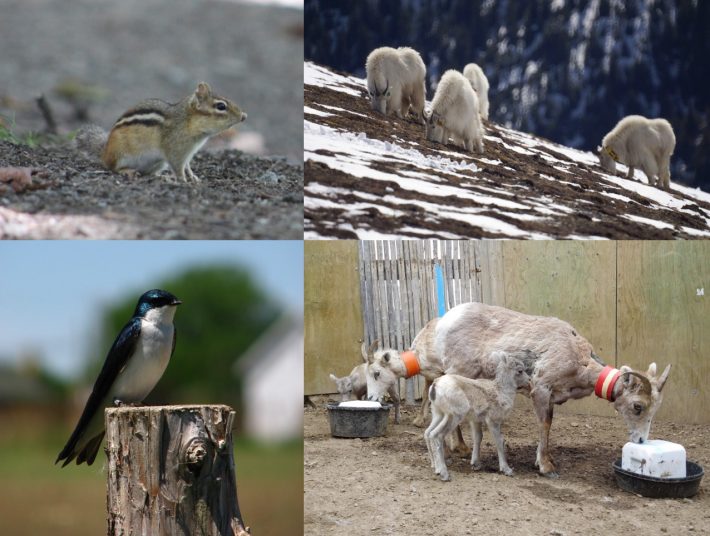Using long-term studies to understand and conserve wildlife
Université de Sherbrooke press release
New research published in Journal of Animal Ecology found that long-term monitoring of bighorn sheep and mountain goats could provide insights into their reproductive tactics.
The researchers argue the importance of long-term studies to understand and conserve wildlife.

Wild animals live in environments that can change substantially from year to year. Therefore, wildlife biologists are interested in how the effects of ecological variables and the consequences of human actions upon wildlife population can also vary over time.
Animal ecologists at the Université de Sherbrooke specialize in long-term monitoring of marked individuals in wild populations. Prof. Marco Festa-Bianchet stated:
“Short-term studies, with one or two years of data, can provide an erroneous or biased impression of what factors drive population dynamics or reproductive tactics.”
“Long-term studies are essential to understand wildlife ecology. Graduate students benefit tremendously from these studies, because they have information on individuals from birth to death. These studies are essential for conservation programs, which rely on long-term trends in abundance”, he added.
Researchers at the Université de Sherbrooke collaborate on research programs that have accumulated 12 to 44 years of data on species as diverse as bighorn sheep, mountain goats, chipmunks, tree swallows, brown bears, caribou and even kangaroos!
Mountain ungulates
The major drivers of population dynamics of mountain ungulates can vary dramatically over time, from predation to population density, to changes in resource availability, to hunting.
In a study just published in Journal of Animal Ecology, Marco Festa-Bianchet and Fanie Pelletier teamed up with Steeve Côté of Université Laval and Sandra Hamel of UiT The Arctic University of Norway to synthesize results of their long-term research on reproductive tactics in bighorn sheep and mountain goats.
In collaboration with other researchers and biologists from Alberta Fish & Wildlife, they monitored more than 2500 marked individuals in three populations, for 30 to 44 years.
These studies show that when resources are scarce, adult females prioritise their own survival over that of their offspring. Reproductive females gain less mass during summer.
Their survival is the same as that of non-reproductive females, and the costs of lactation are generally passed on to offspring born the following year, whose survival and mass gain decrease. Sons are more expensive than daughters, so siblings born after a brother fare worse than those born after a sister.
These negative effects on juveniles, however, vary over time as a function of resource availability, disease prevalence and population density.
For adult males, reproduction requires fighting other males for access to females. Consequently, energetic costs and risk of injury are more associated with attempts to reproduce than with successful reproduction.
None of these discoveries on mountain ungulates would have been possible without long-term monitoring.
Marc-Antoine Poirier’s award-winning video describes in French the supplementation of the Ram Mountain population to attempt a genetic rescue following a population bottleneck.
Chipmunks
Many deciduous trees, including oak, ash and beech, produce a large quantity of seeds every two to three years. These are called mast years, and provide huge amounts of food for small mammals, with consequences that riverberate through the ecosystem
Long-term monitoring shows that chipmunk reproduction peaks in mast years, when they have access to abundant food.
Small mammals whose reproduction depends on mast years have important impacts on forest ecology. It takes six years or more just to document two masting episodes. Therefore, only long-term studies can explore the relationships between chipmunks and their environment.
Tree swallows
Birds that catch insects on the wing, including swallows, martins, swifts and nightjars, are declining drastically. The main driver of this decline is likely the increased use of agricultural pesticides.
Over 15 years of monitoring of tree swallows, however, Sherbrooke researchers have found strong year-to-year changes in the availability of insect prey, mainly due to changes in temperature.
Insect availability affects the ability of parents to feed nestlings, and ultimately their reproductive success. Again, any one or two years of data on this population may lead to incomplete, and possibly erroneous, conclusions.
Read full study (free to read for a limited time):
Festa-Bianchet, M, Cote, S. Hamel, S, Pelletier, F. Long-term studies of bighorn sheep and mountain goats reveal fitness costs of reproduction. J Animal Ecology 2019. DOI: 10.1111/1365-2656.13002
Media contact:
Johanne Leroux, Université de Sherbrooke, Email: Johanne.Leroux2@USherbrooke.ca
Like what we stand for?
Support our mission and help develop the next generation of ecologists by donating to the British Ecological Society.